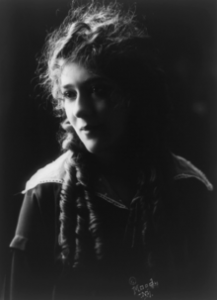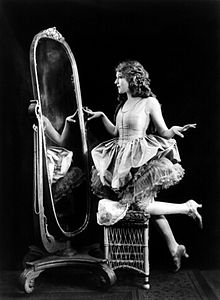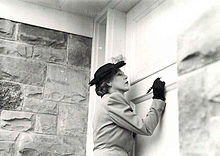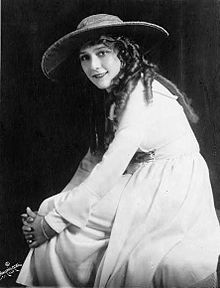Mary Pickford
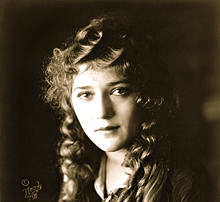
Mary Pickford (PBS Special)
Portrait photograph, 1914
Mary Pickford (April 8, 1892 – May 29, 1979) was a Canadian-American motion picture actress, co-founder of the film studio United Artists and one of the original 36 founders of the Academy of Motion Picture Arts and Sciences. Known as “America’s Sweetheart,” “Little Mary” and “The girl with the curls,” she was one of the Canadian pioneers in early Hollywood and a significant figure in the development of film acting.
Because her international fame was triggered by moving images, she is a watershed figure in the history of modern celebrity and, as one of silent film‘s most important performers and producers, her contract demands were central to shaping the Hollywood industry. In consideration of her contributions to American cinema, the American Film Institute named Pickford 24th among the greatest female stars of all time.
Early years
By the early 1900s, acting had become a family enterprise. Pickford, her mother and two younger siblings toured the United States by rail in third-rate companies and plays. After six impoverished years, Pickford allowed one more summer to land a leading role on Broadway, planning to quit acting if she failed. In 1906 Mary, Lottie and Jack supported the great Irish American singer Chauncey Olcott on Broadway in the play Edmund Burke. Mary finally landed a supporting role in a 1907 Broadway play, The Warrens of Virginia. The play was written by William C. deMille, whose brother, the then-unknown Cecil B. DeMille, also appeared in the cast. David Belasco, the producer of the play, insisted that Gladys Smith assume the stage name Mary Pickford. After completing the Broadway run and touring the play, however, Pickford was once again out of work.
On April 19, 1909, the Biograph Company director D. W. Griffith screen-tested her at the company’s New York studio for a role in the nickelodeon film Pippa Passes. The role went to someone else but Griffith was immediately taken with Pickford. She quickly grasped that movie acting was simpler than the stylized stage acting of the day.
Most Biograph actors earned $5 a day but, after Pickford’s single day in the studio, Griffith agreed to pay her $10 a day against a guarantee of $40 a week. Pickford, like all actors at Biograph, played both bit parts and leading roles, playing mothers, ingenues, spurned women, spitfires, slaves, native Americans, and a prostitute. As Pickford said of her success at Biograph: “I played scrubwomen and secretaries and women of all nationalities… I decided that if I could get into as many pictures as possible, I’d become known, and there would be a demand for my work.” Pickford appeared in 51 films in 1909 – almost one a week. She also introduced her friend Florence La Badie to D. W. Griffith, which launched La Badie’s successful film acting career.
In January 1910, Pickford traveled with a Biograph crew to Los Angeles. Many other companies wintered on the West Coast, escaping the weak light and short days that hampered winter shooting in the East. Pickford added to her 1909 Biographs (Sweet and Twenty, They Would Elope, and To Save Her Soul, to name a few) with films from California. Actors were not listed in the credits in Griffith’s company. Audiences nonetheless noticed and identified Pickford within weeks of her first film appearance. Exhibitors in turn capitalized on her popularity by advertising on sandwich boards that a film featuring “The Girl with the Golden Curls,” “Blondilocks” or “The Biograph Girl” was inside. Pickford left Biograph in December 1910 and spent 1911 starring in films at Carl Laemmle‘s Independent Moving Pictures Company (IMP). IMP was absorbed into Universal Pictures in 1912, along with Majestic. Unhappy with their creative standards, she returned to work with Griffith in 1912. Some of her best performances were in films such as Friends, The Mender of Nets, Just Like a Woman, and The Female of the Species. That year Pickford also introduced Dorothy and Lillian Gish (both friends from her days touring melodrama) to Griffith. Both became major silent stars, in comedy and tragedy respectively.
Pickford made her last Biograph picture, The New York Hat, in late 1912 and returned to Broadway in the David Belasco production of A Good Little Devil. The experience was the major turning point in her career. Pickford, who had always hoped to conquer the Broadway stage, discovered how deeply she missed film acting.
In 1913, she decided to work exclusively in film. In 1912, Adolph Zukor had formed Famous Players in Famous Plays – later Famous Players-Lasky and then Paramount Pictures – one of the first American feature film companies. Pickford left the stage to join his roster of stars. Zukor believed film’s potential lay in recording theatrical players in replicas of their most famous stage roles and productions. Zukor first filmed Pickford in a silent version of A Good Little Devil. The film, produced in 1913, showed the play’s Broadway actors reciting every line of dialogue, resulting in a stiff film that Pickford later called “one of the worst [features] I ever made…it was deadly.” Zukor agreed; he held the film back from distribution for a year.
Pickford’s work in material written for the camera by that time had attracted a strong following. Comedy-dramas like In the Bishop’s Carriage (1913), Caprice (1913), and especially Hearts Adrift (1914) made her irresistible to moviegoers. Hearts Adrift was so popular that Pickford asked for the first of her many publicized pay raises based on the profits and reviews. The film also marked the first time Pickford’s name was put above the title on movie marquees. Tess of the Storm Country was released five weeks later. Brownlow observes that the movie “sent her career into orbit and made her the most popular actress in America, if not the world.”
Her appeal was summed up two years later by the February 1916 issue of Photoplay as “luminous tenderness in a steel band of gutter ferocity.” Only Charlie Chaplin – who reportedly slightly surpassed Pickford’s popularity in 1916 – had a similarly spellbinding pull with critics and the audience. Each enjoyed a level of fame far exceeding that of other actors.
Throughout the 1910s and 1920s, Pickford was believed to be the most famous woman in the world, or, as a silent-film journalist described her, “the best known woman who has ever lived, the woman who was known to more people and loved by more people than any other woman that has been in all history.” Pickford’s closest female rival at this time at the box office and with the public was 31-year-old Marguerite Clark. She also came from stage acting and had a girlish/whimsical charm to which audiences responded.
Stardom
Pickford starred in 52 features throughout her career. In 1916, Pickford signed a new contract with Zukor that granted her full authority over production of the films in which she starred, and a record-breaking salary of $500 a week. Occasionally, she played a child, in films like The Poor Little Rich Girl (1917), Rebecca of Sunnybrook Farm (1917), Daddy-Long-Legs (1919) and Pollyanna (1920). Pickford’s fans were devoted to these “Little Girl” roles, but they were not typical of her career.
In August 1918, Pickford’s contract expired and when refusing Zukor’s terms for a renewal, she was offered $250,000 to leave the motion picture business. Pickford turned him down and went to First National Pictures, which agreed to her terms.
In 1919, Pickford – along with D.W. Griffith, Charlie Chaplin, and Douglas Fairbanks – formed the independent film production company United Artists. Through United Artists, Pickford continued to produce and perform in her own movies; she could also distribute them the way she chose.
In 1920, Pickford’s film Pollyanna grossed around $1,100,000. The following year, Pickford’s film Little Lord Fauntleroy would also be a success, and in 1923, Rosita grossed over $1,000,000 as well. In this period, Pickford also made Sparrows (1926), which blended the Dickensian with newly minted German expressionist style, and the romantic comedy My Best Girl (1927).
 A lobby card for the film Little Lord Fauntleroy, 1921
A lobby card for the film Little Lord Fauntleroy, 1921
The arrival of sound was her undoing. Pickford underestimated the value of adding sound to movies, claiming that “adding sound to movies would be like putting lipstick on the Venus de Milo.”
She played a reckless socialite in Coquette (1929), a role where she no longer had her famous ringlets, but rather a 1920s bob; Pickford had cut her hair in the wake of her mother’s death in 1928. Fans were shocked at the transformation. Pickford’s hair had become a symbol of female virtue, and cutting it was front-page news in The New York Times and other papers. Coquette was a success and won her an Academy Award for Best Actress, but the public failed to respond to her in the more sophisticated roles.
Like most movie stars of the silent era, Pickford found her career fading as talkies became more popular among audiences. Her next film, The Taming of The Shrew, made with husband Douglas Fairbanks, was not well received at the box office.
Hollywood was panicked by the impending arrival of the talkies. On March 29, 1928, a radio show was broadcast from Pickford’s bungalow, featuring Douglas Fairbanks, Charles Chaplin, Norma Talmadge, Gloria Swanson, John Barrymore, D.W. Griffith and Dolores del Rio, among others, to speak on the The Dodge Brothers Hour to prove they could meet the challenge of talking movies.
Now in her late thirties, Pickford was unable to play the children, teenage spitfires and feisty young women so adored by her fans, nor could she play the sleekly elegant heroines of early sound. In 1933, Pickford underwent a Technicolor screen test for an animated/live action film version of Alice in Wonderland, but Walt Disney discarded the project when Paramount released its own version of the book. Only one Technicolor “still” of her screen test still exists.
Pickford retired from acting in 1933. She continued to produce films for others, including Sleep, My Love (1948) with Claudette Colbert and Love Happy (1949) with the Marx Brothers.
The film industry
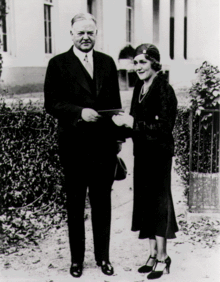 Mary Pickford giving President Herbert Hoover a ticket for a film industry benefit for the unemployed, 1931
Mary Pickford giving President Herbert Hoover a ticket for a film industry benefit for the unemployed, 1931
Pickford used her stature in the movie industry to promote a variety of causes. During World War I, she promoted the sale of Liberty Bonds, through an exhausting series of fund-raising speeches that kicked off in Washington, D.C., where she sold bonds alongside Charles Chaplin, Douglas Fairbanks, Theda Bara, and Marie Dressler. Five days later she spoke on Wall Street to an estimated 50,000 people. Though Canadian-born, she was a powerful symbol of Americana, kissing the American flag for cameras and auctioning one of her world-famous curls for $15,000. In a single speech in Chicago she sold an estimated five million dollars’ worth of bonds. She was christened the U.S. Navy’s official “Little Sister;” the Army named two cannons after her and made her an honorary colonel.
At the end of World War I, Pickford conceived of the Motion Picture Relief Fund, an organization to help financially needy actors. Leftover funds from her work selling Liberty Bonds were put toward its creation, and in 1921, the Motion Picture Relief Fund (MPRF) was officially incorporated, with Joseph Schenck voted its first president and Mary Pickford as its vice president. In 1932, Pickford spearheaded the “Payroll Pledge Program,” a payroll-deduction plan for studio workers who gave one half of one percent of their earnings to the MPRF. As a result, in 1940 the Fund was able to purchase land and build the Motion Picture Country House and Hospital.
But Pickford’s most profound influence (beyond her acting) was to help reshape the film industry itself. When she entered features, Hollywood believed that the movies’ future lay in reproducing Broadway plays for a mass audience. Pickford, who entered feature film with two Broadway credits but a far greater following among fans of nickelodeon flickers, became the world’s most popular actress in a matter of months. In response to her popularity, Hollywood rethought its vision of features as “canned theatre,” and focused instead on actors and material that were uniquely suited to film, not stage performances.
An astute businesswoman, Pickford became her own producer within three years of her start in features. According to her Foundation, “she oversaw every aspect of the making of her films, from hiring talent and crew to overseeing the script, the shooting, the editing, to the final release and promotion of each project.” Pickford first demanded (and received) these powers in 1916, when she was under contract to Adolph Zukor’s Famous Players In Famous Plays (later Paramount). He also acquiesced to her refusal to participate in block-booking, the widespread practice of forcing an exhibitor to show a bad film of the studio’s choosing in order to also show a Pickford film. In 1916, Pickford’s films were distributed, singly, through a special distribution unit called Artcraft.
In 1919, she increased her power by co-founding United Artists (UA) with Charlie Chaplin,D. W. Griffith, and her soon-to-be husband, Douglas Fairbanks. Before UA’s creation, Hollywood studios were vertically integrated, not only producing films but forming chains of theaters. Distributors (also part of the studios) then arranged for company productions to be shown in the company’s movie venues. Filmmakers relied on the studios for bookings; in return they put up with what many considered creative interference. United Artists broke from this tradition. It was solely a distribution company, offering independent film producers access to its own screens as well as the rental of temporarily unbooked cinemas owned by other companies. Pickford and Fairbanks produced and shot their films after 1920 at the jointly owned Pickford-Fairbanks studio on Santa Monica Boulevard. The producers who signed with UA were true independents, producing, creating and controlling their work to an unprecedented degree. As a co-founder, as well as the producer and star of her own films, Pickford became the most powerful woman who has ever worked in Hollywood. By 1930, Pickford’s career as an actress had greatly faded.
When she retired from acting in 1933, Pickford continued to produce films for United Artists, and she and Chaplin remained partners in the company for decades. Chaplin left the company in 1955, and Pickford followed suit in 1956, selling her remaining shares for three million dollars.
Personal life
Pickford was married three times. She married Owen Moore, an Irish-born silent film actor, on January 7, 1911. It is believed she became pregnant by Moore in the early 1910s and had a miscarriage or an abortion. Some accounts suggest this led to her inability to have children. The couple had numerous marital problems, notably Moore’s alcoholism, insecurity about living in the shadow of Pickford’s fame, and bouts of domestic violence. The failure of her pregnancy may have exacerbated Moore’s drinking problem. The couple lived apart for several years.
Pickford became secretly involved in a relationship with Douglas Fairbanks. They toured the US together in 1918 to promote Liberty Bond sales for the World War I effort. Around this time, Pickford also suffered from a bout of the flu during the 1918 flu pandemic, but survived. Pickford divorced Moore on March 2, 1920, and married Fairbanks on March 28 of the same year. They went to Europe for their honeymoon; fans in London and in Paris caused riots trying to get to the famous couple. The couple’s triumphant return to Hollywood was witnessed by vast crowds who turned out to hail them at railway stations across the United States.
The Mark of Zorro (1920) and a series of other swashbucklers gave the popular Fairbanks a more romantic, heroic image. Pickford continued to epitomize the virtuous but fiery girl next door. Even at private parties people instinctively stood up when Pickford entered a room; she and her husband were often referred to as “Hollywood royalty.” Their international reputations were broad. Foreign heads of state and dignitaries who visited the White House often asked if they could also visit Pickfair, the couple’s mansion in Beverly Hills.
Dinners at Pickfair included a number of notable guests. Charlie Chaplin, Fairbanks’ best friend, was often present. Other guests included George Bernard Shaw, Albert Einstein, Elinor Glyn, Helen Keller, H. G. Wells, Lord Mountbatten, Fritz Kreisler, Amelia Earhart, F. Scott Fitzgerald, Noël Coward, Max Reinhardt, Baron Nishi, Vladimir Nemirovich-Danchenko, Sir Arthur Conan Doyle, Austen Chamberlain, Sir Harry Lauder, and the Indian spiritual teacher Meher Baba. The public nature of Pickford’s second marriage strained it to the breaking point. Both she and Fairbanks had little time off from producing and acting in their films. They were also constantly on display as America’s unofficial ambassadors to the world, leading parades, cutting ribbons, and making speeches.
When their film careers both began to founder at the end of the silent era, Fairbanks’ restless nature prompted him to overseas travel (something which Pickford did not enjoy). When Fairbanks’ romance with Sylvia, Lady Ashley became public in the early 1930s he and Pickford separated. They divorced January 10, 1936. Fairbanks’ son by his first wife, Douglas Fairbanks Jr., claimed that his father and Pickford long regretted their inability to reconcile.
On June 24, 1937, Pickford married her third and last husband, actor and band leader Charles ‘Buddy’ Rogers. They adopted two children: Roxanne (born 1944, adopted 1944) and Ronald Charles (born 1937, adopted 1943, a.k.a. Ron Pickford Rogers). As a PBSAmerican Experience documentary noted, Pickford’s relationship with her children was tense. She criticized their physical imperfections, including Ronnie’s small stature and Roxanne’s crooked teeth. Both children later said that their mother was too self-absorbed to provide real maternal love. In 2003, Ronnie recalled that “Things didn’t work out that much, you know. But I’ll never forget her. I think that she was a good woman.”
Later years
After retiring from the screen, Pickford became an alcoholic, as her father had before her. Other alcoholics in the family included her first husband Owen Moore, her mother Charlotte, and her younger siblings Lottie and Jack. Charlotte died of breast cancer in March 1928 after several operations. Within a few years, Lottie and Jack died of alcohol-related causes.
These deaths, her divorce from Fairbanks, and the end of silent films left Pickford deeply depressed. Her relationship with her children, Roxanne and Ronald, was turbulent at best. Pickford gradually became a recluse, remaining almost entirely at Pickfair and allowing visits only from Lillian Gish, her stepson Douglas Fairbanks, Jr., and a few select others. In the mid-1960s, she often received visitors only by telephone, speaking to them from her bedroom. Buddy Rogers often gave guests tours of Pickfair, including views of a genuine western bar Pickford had bought for Douglas Fairbanks, and a portrait of Pickford in the drawing room. A print of this image now hangs in the Library of Congress.
In addition to her Oscar as best actress for Coquette (1929), Mary Pickford received an Academy Honorary Award for a lifetime of achievements in 1976. The Academy sent a TV crew to her house to record her short statement of thanks.
Pickford had become an American citizen upon her marriage to Douglas Fairbanks in 1920. Towards the end of her life, Pickford made arrangements with the Department of Citizenship to regain her Canadian citizenship because she wished to “die as a Canadian”. Her request was approved and she became a dual Canadian-American citizen.
Death
On May 29, 1979, Pickford died at a Santa Monica hospital of complications from a cerebral hemorrhage she had suffered the week before.
Pickford was buried in the Garden of Memory of the Forest Lawn Memorial Park Cemetery in Glendale, California. Buried alongside her in the Pickford private family plot are her mother Charlotte, her siblings Lottie and Jack Pickford, and the family of Elizabeth Watson, Charlotte’s sister, who had helped raise Pickford in Toronto.


